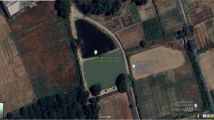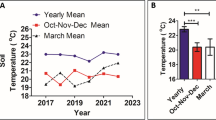Abstract
In the current study, thirty bacterial strains isolated from the rhizosphere of Clerodendrum infortunatum L. were evaluated for the properties related to the plant growth promotion and disease resistance. Here, all the selected strains were screened for its antagonistic effect towards the phytopathogen Sclerotium rolfsii and also for the production of bioactive compounds known to promote the plant growth. Among these isolates, CiRb1 and CiRb16 were observed to have a broad range of plant beneficial features and were identified as Bacillus licheniformis and Bacillus velezensis respectively. Both the isolates were also demonstrated to produce the volatile organic compounds (VOCs) responsible for the growth enhancement in Brassica nigra (L.) and growth inhibition of S. rolfsii. Talc based formulations made out of both B. licheniformis and B. velezensis were further demonstrated to augment the plant growth and protection against S. rolfsii in Vigna unguiculata (L.) Walp. By the GC–MS based analysis, undecane could also be detected in the methanolic extracts prepared from both B. licheniformis and B. velezensis. Here, the selected rhizobacterial isolates were found to promote the plant growth and disease resistance through both direct and VOC mediated mechanisms. The results of the study hence reveal both B. licheniformis and B. velezensis have the potential in field application to promote the growth and control of plant diseases.





Similar content being viewed by others
Data Availability
The datasets generated during and/or analysed during the current study are available from the corresponding author on reasonable request.
Code Availability
Not applicable.
References
Armada E, Roldán A, Azcon R (2013) Differential activity of autochthonous bacteria in controlling drought stress in native Lavandula and Salvia plants species under drought conditions in natural arid soil. Microb Ecol 67(2):410–420. https://doi.org/10.1007/s00248-013-0326-9
**ong Q, Hu J, Wei H, Zhang H, Zhu J (2021) Relationship between plant roots, rhizosphere microorganisms, and nitrogen and its special focus on rice. Agriculture 11(3):234. https://doi.org/10.3390/agriculture11030234
Thomashow LS, Weller DM (1988) Role of a phenazine antibiotic from Pseudomonas fluorescens in biological control of Gaeumannomyces graminis var. tritici. J Bacteriol 170(8):3499–3508
Oleńska E, Małek W, Wójcik M, Swiecicka I, Thijs S, Vangronsveld J (2020) Beneficial features of plant growth-promoting rhizobacteria for improving plant growth and health in challenging conditions: a methodical review. Sci Total Environ 743:140682
Mitra D, Mondal R, Khoshru B, Senapati A, Radha TK, Mahakur B, Mohapatra PKD et al (2022) Actinobacteria-enhanced plant growth, nutrient acquisition, and crop protection: advances in soil, plant, and microbial multifactorial interactions. Pedosphere 32(1):149–170
Nakkeeran S, Fernando WGD, Siddiqui ZA (2006) Plant growth promoting rhizobacteria formulations and its scope in commercialization for the management of pests and diseases. PGPR. https://doi.org/10.1007/1-4020-4152-7_10
Gamalero E, Lingua G, Berta G, Glick BR (2009) Beneficial role of plant growth promoting bacteria and arbuscular mycorrhizal fungi on plant responses to heavy metal stress. Can J Microbiol 55(5):501–514. https://doi.org/10.1139/w09-010
Steane DA, Scotland RW, Mabberley DJ, Olmstead RG (1999) Molecular systematics of Clerodendrum (Lamiaceae): ITS sequences and total evidence. Am J Bot 86(1):98–107
Dinesh R, Anandaraj M, Kumar A, Bini YK, Subila KP, Aravind R (2015) Isolation, characterization, and evaluation of multi-trait plant growth promoting rhizobacteria for their growth promoting and disease suppressing effects on ginger. Microbiol Res 173:34–43. https://doi.org/10.1016/j.micres.2015.01.014
Rohini S, Aswani R, Kannan M, Sylas VP, Radhakrishnan EK (2018) Culturable endophytic bacteria of ginger rhizome and their remarkable multi-trait plant growth-promoting features. Curr Microbiol 75:505–511. https://doi.org/10.1007/s00284-017-1410-z
Jasim B, Joseph AA, John CJ, Mathew J, Radhakrishnan EK (2014) Isolation and characterization of plant growth promoting endophytic bacteria from the rhizome of Zingiber officinale. 3 Biotech 4(2):197–204. https://doi.org/10.1007/s13205-013-0143-3
Sabu R, Aswani R, Jishma P, Jasim B, Mathew J, Radhakrishnan EK (2019) Plant growth promoting endophytic Serratia sp. ZoB14 protecting ginger from fungal pathogens. Proc Natl Acad Sci India Sect B 89:213–220
Ahmad F, Ahmad I, Khan MS (2008) Screening of free-living rhizospheric bacteria for their multiple plant growth promoting activities. Microbiol Res 163(2):173–181. https://doi.org/10.1016/j.micres.2006.04.001
Rijavec T, Lapanje A (2016) Hydrogen cyanide in the rhizosphere: not suppressing plant pathogens, but rather regulating availability of phosphate. Front Microbiol. https://doi.org/10.3389/fmicb.2016.01785
Farhaoui A, Adadi A, Tahiri A, El Alami N, Khayi S, Mentag R, Lahlali R et al (2022) Biocontrol potential of plant growth-promoting rhizobacteria (PGPR) against Sclerotiorum rolfsii diseases on sugar beet (Beta vulgaris L.). Physiol Mol Plant Pathol 119:101829
Jasim B, Mathew J, Radhakrishnan EK (2016) Identification of a novel endophytic Bacillus sp. from Capsicum annuum with highly efficient and broad spectrum plant probiotic effect. J Appl Microbiol 121(4):1079–1094. https://doi.org/10.1111/jam.13214
Wang C, Wang Z, Qiao X, Li Z, Li F, Chen M, Wang Y, Huang Y, Cui H (2013) Antifungal activity of volatile organic compounds fromStreptomyces alboflavusTD-1. FEMS Microbiol Lett 341(1):45–51. https://doi.org/10.1111/1574-6968.12088
Jasim B, Sreelakshmi KS, Mathew J, Radhakrishnan EK (2016) Surfactin, iturin, and fengycin biosynthesis by endophytic Bacillus sp. from Bacopa monnieri. Microb Ecol 72(1):106–119. https://doi.org/10.1007/s00248-016-0753-5
Jasim B, Sreelakshmi S, Mathew J, Radhakrishnan EK (2016) Identification of endophytic Bacillus mojavensis with highly specialized broad spectrum antibacterial activity. 3 Biotech. https://doi.org/10.1007/s13205-016-0508-5
Jimtha John C, Jishma P, Arathy GB, Anisha C, Radhakrishnan EK (2016) Identification of plant growth promoting rhizosphere Bacillus sp. WG4 antagonistic to Pythium myriotylum and its enhanced antifungal effect in association with Trichoderma. J Soil Sci Plant Nutr 16(3):578–590. https://doi.org/10.4067/s0718-95162016005000026
Basheer J, Ravi A, Mathew J, Krishnankutty RE (2019) Assessment of plant-probiotic performance of novel endophytic Bacillus sp. Talc-Based Formul Probiot Antimicrobial Proteins 11(1):256–263. https://doi.org/10.1007/s12602-018-9386-y
Panichikkal J, Puthiyattil N, Raveendran A, Nair RA, Krishnankutty RE (2021) Application of encapsulated Bacillus licheniformis supplemented with chitosan nanoparticles and rice starch for the control of Sclerotium rolfsii in Capsicum annuum (L.) seedlings. Curr Microbiol 78:911–919. https://doi.org/10.1007/s00284-021-02361-8
Jishma P, Shad KS, Athulya EC, Sachidanandan P, Radhakrishnan EK (2021) Rhizospheric Pseudomonas spp. with plant growth promotion and antifungal properties against Sclerotium rolfsii mediated pathogenesis in Vigna unguiculata. Plant Biotechnol Rep 15(4):483–491. https://doi.org/10.1007/s11816-021-00687-0
Rakhimol KR, Ashitha A, Thomas S, Kalarikkal N, Jayachandran K (2023) Casein stabilized metal and metal oxide nanoparticle to eradicate the endophytic bacterial contamination from in vitro culturing of Scoparia dulcis L. Plant Cell Tissue Organ Cult (PCTOC). https://doi.org/10.1007/s11240-023-02541-3
Johann S, Pizzolatti MG, Donnici CL, Resende MAd (2007) Antifungal properties of plants used in Brazilian traditional medicine against clinically relevant fungal pathogens. Braz J Microbiol 38(4):632–637. https://doi.org/10.1590/s1517-83822007000400010
Das S, Theresa M (2023) 9-Tricosene containing blend of volatiles produced by Serratia sp. NhPB1 isolated from the pitcher plant provide plant protection against Pythium aphanidermatum. Appl Biochem Biotechnol. https://doi.org/10.1007/s12010-023-04352-w
Tahir HAS, Gu Q, Wu H, Raza W, Hanif A, Wu L, Colman MV, Gao X (2017) Plant growth promotion by volatile organic compounds produced by Bacillus subtilis SYST2. Front Microbiol. https://doi.org/10.3389/fmicb.2017.00171
Liu Y, Zhang W, Zhang Z, Kou Z, Wang X, Wang Y, Tian Y (2024) Biocontrol effects of three antagonistic bacteria strains against Codonopsis pilosula wilt disease caused by Fusarium oxysporum. Biol Control 105:446. https://doi.org/10.1016/j.biocontrol.2024.105446
Ruangwong OU, Wonglom P, Suwannarach N, Kumla J, Thaochan N, Chomnunti P, Sunpapao A (2021) Volatile organic compound from Trichoderma asperelloides TSU1: impact on plant pathogenic fungi. J Fungi 7(3):187. https://doi.org/10.3390/jof7030187
Nakkeeran S, Priyanka R, Rajamanickam S, Sivakumar U (2020) Bacillus amyloliquefaciens alters the diversity of volatile and non-volatile metabolites and induces the expression of defence genes for the management of Botrytis leaf blight of Lilium under protected conditions. J Plant Pathol 102:1179–1189. https://doi.org/10.1007/s42161-020-00602-6
Chakraborty U, Chakraborty BN, Basnet M, Chakraborty AP (2009) Evaluation of Ochrobactrum anthropi TRS-2 and its talc based formulation for enhancement of growth of tea plants and management of brown root rot disease. J Appl Microbiol 107(2):625–634. https://doi.org/10.1111/j.1365-2672.2009.04242.x
Pandey N, Rajavat AS, Vaishnav R, Singh AN, Kumar S, Mishra V, Shrivastava N (2024) Mining of rice rhizobacteria to control false smut and improve plant growth in rice (Oryza sativa L.). Eur J Plant Pathol 169:1–14
Nagrale DT, Gawande SP, Shah V, Verma P, Hiremani NS, Prabhulinga T, Waghmare VN (2022) Biocontrol potential of volatile organic compounds (VOCs) produced by cotton endophytic rhizobacteria against Macrophomina phaseolina. Eur J Plant Pathol 163(2):467–482
Acknowledgements
The authors acknowledge Kerala State Council for Science, Technology and Environment (KSCSTE)-Science Research Scheme (SRS) for the financial support and JAIVAM and KSCSTE- KBC- YIPB project for the support. The authors also acknowledge the Department of Science and Technology under DST- PURSE for the GC-MS instrumentation facility.
Funding
Funding received from Kerala State Council for Science, Technology and Environment (KSCSTE)-Science Research Scheme (SRS) during the study.
Author information
Authors and Affiliations
Contributions
Radhakrishnan Edayileveetil Krishnankutty contributed to the study conception and design. Experiments and analyses were performed by Jishma Panichikkal and Smruthy Manu. The first draft of the manuscript was written by Jishma Panichikkal and Radhakrishnan Edayileveetil Krishnankutty. The manuscript was revised and corrections were included by Radhakrishnan Edayileveetil Krishnankutty. All authors commented on previous versions of the manuscript. All authors read and approved the final manuscript.
Corresponding author
Ethics declarations
Competing Interests
The authors have no competing interests to declare.
Ethical Approval
This article does not contain any studies with human participants or animals performed by any of the authors.
Consent to Participate
Not applicable.
Consent for Publication
Not applicable.
Additional information
Publisher's Note
Springer Nature remains neutral with regard to jurisdictional claims in published maps and institutional affiliations.
Supplementary Information
Below is the link to the electronic supplementary material.
Rights and permissions
Springer Nature or its licensor (e.g. a society or other partner) holds exclusive rights to this article under a publishing agreement with the author(s) or other rightsholder(s); author self-archiving of the accepted manuscript version of this article is solely governed by the terms of such publishing agreement and applicable law.
About this article
Cite this article
Panichikkal, J., Manu, S. & Krishnankutty, R.E. Bacillus licheniformis and Bacillus velezensis from Rhizosphere of Clerodendrum infortunatum L. Promote Plant Growth and Resistance to Sclerotium rolfsii in Vigna unguiculata (L.) Walp.. Curr Microbiol 81, 238 (2024). https://doi.org/10.1007/s00284-024-03749-y
Received:
Accepted:
Published:
DOI: https://doi.org/10.1007/s00284-024-03749-y




